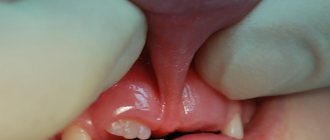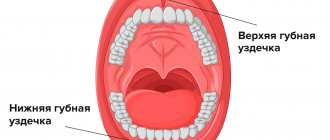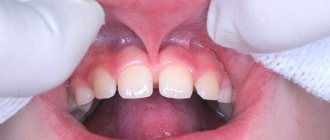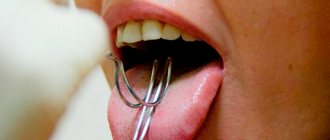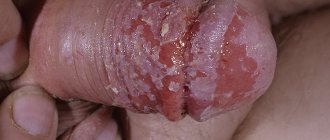The frenulum of the tongue performs important functions, among which are ensuring correct pronunciation, maintaining the health of the mucous membranes, maintaining the facial muscles, and participating in the formation of the bite. Sometimes, in order to restore all these functions, it is necessary to perform surgical plastic surgery of the organ. This procedure is not particularly difficult and is performed mainly in childhood. However, it is not uncommon for adult patients to need correction of the shape of the tongue frenulum.
Symptoms of incorrect placement of the frenulum of the tongue
With significant pathology of the frenulum, the following symptoms may be observed:
- It is impossible to stick the tongue out of the mouth due to the short length of the frenulum.
- When trying to stretch the tongue, it bends and takes an arched shape.
- When you try to reach the palate with your tongue, the tip of the organ expands, as there is a strong tension.
- When at rest, the tongue has the shape of a groove.
If you have such symptoms and discomfort, you should consult a specialist. Perhaps the doctor will conduct a more thorough diagnosis and make a diagnosis.
How to check if a child has a short frenulum
The presence of difficulties with the frenulum can be easily determined independently:
- Open your mouth slightly and place the tip of your tongue in the area behind your upper teeth. In this position, the place of attachment of the frenulum is clearly visible. If it is not “where it needs to be,” it is difficult to lift the tongue up.
- Pull your tongue forward. A short frenulum does not allow this to be done; in addition, the tip of the tongue visually looks forked
- Open your mouth and try to touch your upper lip with your tongue and lick it. Difficulties with the bridle make this movement difficult to perform.
Please note: sometimes a child cannot cope with these exercises not because there is something wrong with the frenulum. The cause may be weak muscles of the articulatory apparatus. Take a clean handkerchief and try to help your tongue. If resistance is felt when moving, then the problem is still in the hyoid frenulum.
Indications and contraindications for the procedure
Indications:
- Restoring sucking function in infants.
- Speech defects.
- Delayed development of the lower jaw.
- Not chewing food thoroughly.
- Malocclusion.
- Too dense arrangement of teeth or presence of gaps between them.
- Difficulties during orthodontic treatment.
- Preparation for implantation.
Contraindications:
- Poor blood clotting.
- Presence of cancerous tumors.
- Infectious diseases.
- Inflammatory processes in the oral cavity.
- The presence of carious lesions and inflammation of the dental nerve.
If there are problems with breastfeeding, surgery is often performed in the maternity hospital. In older children, the procedure is performed if there are discomfort or problems with diction.
Why does a short frenulum of the foreskin develop?
In the vast majority of cases, this defect is congenital, often combined with a pathological condition such as phimosis. The latter is characterized by the narrowness of the foreskin, which does not allow the head of the penis to be exposed.
It is found in 96% of newborn boys, but as their body develops, the foreskin gains the necessary mobility, and the problem goes away on its own. At the age of three, it is found in only 10% of young patients.
The causes of a short frenulum are as follows:
- different rates of development of skin structures and cavernous bodies of the penis;
- inflammatory processes of the structures of the penis, occurring in a chronic form;
- constant injury to the foreskin when playing sports, wearing incorrectly selected underwear and too tight trousers;
- diabetes mellitus, which provokes failures in tissue regeneration.
Preparing for surgery
Before the procedure, it is necessary to perform a number of preparatory measures:
- Consult a specialist.
- Perform diagnostic tests.
- At least 2 weeks before surgery, donate urine and blood for analysis, undergo testing for blood clotting, viral hepatitis, and HIV.
- Adult patients should undergo fluorography and, if necessary, an electrocardiogram.
- Take a test for an allergic reaction to the drugs used.
- Immediately before the operation, it is better to eat a hearty meal, since after the procedure this will not be possible for several hours.
- Perform professional oral hygiene and treat it with an antiseptic.
Methods of plastic surgery of the frenulum of the tongue
- Frenotomy (transverse intersection). This is the easiest way to correct the frenulum, with which you can correct the small thickness or width of the organ.
- Frenectomy (removal of a fragment of the frenulum). The method is used when the thickness and width of the hyoid fold is too large.
- Frenuloplasty (cutting and relocation). The technique helps to get rid of the pathology of fusion of the frenulum with the floor of the mouth or lower lip.
Frenotomy and frenectomy are fairly simple techniques that can be performed with a scalpel or laser. Frenuloplasty requires certain skills from the surgeon. The more preferable method of performing tongue frenuloplasty is the laser technique. Using a laser has a number of advantages:
- Speed of the procedure.
- No need for stitches.
- No bleeding during surgery.
- Instant disinfection of the cut surface.
- No scars after plastic surgery.
- Fast and comfortable recovery period.
Laser correction is often used in children, since surgical instruments that frighten the child are not used during the procedure. In addition, wound healing occurs much faster than after using a scalpel.
The frenuloplasty lasts no more than 30 minutes. Children need to remain calm for at least 15 minutes.
Recovery period
After plastic surgery of the frenulum of the tongue, in most cases, experts give the following recommendations for effective recovery:
- Do not eat or drink for several hours after the intervention. Drinking water is allowed.
- Visit your doctor as scheduled.
- Avoid eating hard and spicy foods while the wound is healing.
- Perform oral hygiene thoroughly and regularly. After each meal, rinse with an antiseptic solution.
- Do the exercises that the doctor tells you about.
Is it painful to perform lingual frenuloplasty?
Many parents worry about anesthesia, since tongue frenulum correction is mostly performed on children. Experts reassure: there will be no pain, since high-quality local anesthesia is used during plastic surgery. If the operation is performed with a laser, then you can do without anesthetics altogether. This technique is used in newborns. If pain relief is necessary, topical anesthetics in the form of gels, sprays, and ointments can be used.
Frenules in the oral cavity
These small mucous strands can affect the clarity of speech, the aesthetics of a smile; in infants, the frenulum of the oral cavity can affect the quality of attachment to the breast, or the ability to suck a bottle. It is for this reason that parents should pay attention to these anatomical formations. If the frenulum(s) of the oral cavity are short, the baby will not be able to eat properly, attach to the breast, and therefore will get tired faster, remaining hungry. There can be no talk of any increase in the child’s weight or height. Parents should remember and be aware of this problem and be able to notice alarming symptoms. According to statistics, a large percentage of short frenulums are registered in children, on average every 14 children. If the problem is diagnosed in time, it is possible to avoid those complications that can cause short frenulum. Anatomy of the oral cavity There are three frenulums in the child’s oral cavity , and not one, as many parents believe. After all, the more “ famous ” is the frenulum of the tongue, which is attached to the underside of the tongue and sublingual space. The frenulum of the tongue is rightfully considered the most insidious, but at the same time practically the most important. In addition to the frenulum of the tongue, in the baby’s mouth there are also frenulums of the upper and lower lips, which are also assigned certain functions. The frenulum on the upper lip should be woven into the upper lip and into the mucous membrane of the gums, just above the level of the front incisors. The frenulum on the lower lip is woven in the same way as the upper lip. As a rule, a short frenulum in the mouth can be diagnosed in the parent department; this is more true for a short frenulum of the tongue. As for the rest of the frenulum of the oral cavity, diagnosis mainly occurs in the dentist's chair at a random appointment. There are cases when a tongue frenulum is not immediately diagnosed, and the frenulum in no way interferes with the feeding of the baby. But subsequently, the child may pronounce incorrectly defined sounds, and then the question of a short frenulum of the tongue comes up again, which, as a rule, is diagnosed at an appointment with a speech therapist. Upper lip frenulum When diagnosing a short frenulum, there are usually no difficulties, even for parents. To do this, you just need to carefully pull back the upper lip at rest and see at what level the mucous cord is attached. Normally, attachment should occur 5–8 mm from the neck of the child’s incisors. If the frenulum is attached lower or its attachment is not visible at all, then we can talk about a short frenulum. What are the dangers of having a short frenulum? In a newborn baby, a short frenulum on the upper lip can affect breastfeeding; the baby simply cannot position the upper lip correctly and correctly grasp the mother's breast. Only in this case can the frenulum of the upper lip be corrected in the maternity hospital. Fortunately, this happens quite rarely. At an older age, a short frenulum in the oral cavity can affect the aesthetics of a smile, since a gap is formed between the child’s front teeth - a diastema (trema). Typically, children are embarrassed by such diastemas, especially teenagers, and try to smile or talk less. Such gaps between teeth are considered dental defects that require orthodontic treatment, sometimes in combination with surgery. But it is worth remembering that an aesthetic defect is not the only problem that can be caused by a short frenulum of the upper lip; the most serious complication is problems with bite, namely the protrusion of the front incisors forward. The protrusion of the front incisors occurs as a result of pressure. The fact is that when talking or eating, the lips are involved, and the frenulum connects the lip and the alveolar process and pulls it along with it, while mechanically acting on the jaw in the area of the incisors, promoting their advancement forward. The solution to this problem is orthodontic, and requires a fairly large investment of time and money. In fairness, it is worth noting that such a scenario can only develop in children with permanent incisors; if the baby still has a milk bite, then there is no need to worry. Excessive tension of the gum mucosa can provoke inflammatory diseases in the area of the front incisors - gingivitis, periodontitis. As a result, the child may develop increased tooth sensitivity. Speech defects may also be characteristic of a short frenulum; the toddler cannot correctly pronounce some sounds that the baby uses his lips to pronounce, such as “o”, “u”, etc. In addition, inflammatory diseases in the gum area can cause caries in the area of the necks of the teeth. Due to the low attachment of the frenulum, a large amount of plaque accumulates in the incisor area, and it is quite difficult to remove. How does the correction happen? Correction can be done exclusively surgically, but it is worth remembering some features. Correction of the frenulum on the upper lip is indicated only after or during the eruption of the permanent incisors! Usually this is 6 - 8 years old; until this age, parents should not worry. It is not recommended to perform the operation before this period, with the only exception in the maternity hospital. Otherwise, such actions may result in bite pathology. A shortened and thick frenulum of the upper lip in a primary occlusion is not a pathology, but a variant of the norm; as the jaws grow, the frenulum can self-correct, i.e. stretch out and change its place of attachment. It is for these reasons that the most optimal time for correction is the time when all the permanent incisors on the upper jaw have erupted, and active eruption of the canines begins, or when the anterior permanent incisors are erupting, and when the lateral incisors are actively erupting. The fact is that when the frenulum is corrected at this time, the erupting teeth will move the teeth towards each other and the gap between the teeth will close on their own, and there will be no need for orthodontic treatment. If it was not possible to correct the frenulum in time, it is necessary to use orthodontic treatment, when the doctor places a “brace” on the front teeth, which will bring the incisors together. Surgical treatment Dentists can use 3 types of surgical treatment : Frenotomy - dissection; Frenectomy - excision; Frenuloplasty – relocation of the frenulum attachment site. Children can cut the frenulum on their own, and cases of such injuries are quite common. For example, if you fall or chew toys too hard, the frenulum may rupture, which is accompanied by bleeding and hematoma. In case of injury, you must immediately consult a dentist to decide the future fate of the injured frenulum. Frenectomy allows you to solve this problem, and even with trauma to the oral cavity, ruptures of the frenulum, as a rule, do not occur. The operations themselves are performed in a surgical clinic, using local anesthesia, and the procedure usually does not take more than 30 minutes. After cutting the frenulum, the doctor places sutures made of a special biomaterial that dissolves on its own, which avoids the unpleasant procedure of removing them. The recovery period after the procedure is not long and takes from several hours to several days. And as soon as the swelling subsides after the operation, parents note that the child begins to pronounce sounds more clearly, or grasps the mother’s breast more freely. The operation can be performed using various instruments - surgical scissors or a scalpel, or using a laser. Using the latter technique is the most acceptable, as it avoids stitches and significantly reduces the baby’s recovery time. Most often, the frenulum is corrected in young children using a scalpel, the amount of time spent is reduced, and immediate attachment to the chest is a prerequisite. Frenulum on the lower lip The frenulum of the lower lip may not be present or it may be forked. In order to diagnose a frenulum on the lower lip, it is necessary to retract the lower lip. At the same time, the frenulum itself becomes noticeable, which runs from the middle of the alveolar process of the lower jaw, intertwining below the area of the lower incisors, and attaching to the lower lip. Under normal conditions, the frenulum should be thin and almost invisible, in addition, it should be flush with the center line. If the baby's frenulum is thick, short and attached at the base of the lower incisors, the frenulum is short. Why is a short frenulum of the lower lip dangerous? By analogy with the frenulum on the upper jaw, the sucking function of a toddler may suffer. When sucking, the short frenulum pulls the lower lip along with it, thereby breaking the vacuum that is formed during sucking. The baby needs more effort, the baby quickly gets tired, remaining hungry and abandoning the breast. In this case, frenuloplasty can be performed in the maternity ward. A short frenulum can also cause malocclusion, inflammatory and carious diseases in the area of the lower front incisors. The formation of spaces between the lower anterior incisors is a rather rare phenomenon, but can still be diagnosed if the frenulum is woven into the area of the gingival papilla between the anterior incisors of the lower jaw. Treatment The operation can be performed on children of different ages, but most often these are children with fully erupted permanent incisors. No less often, the frenulum can be cut already in adulthood, when it comes to prosthetics of the lower jaw. The operation itself is carried out in a clinic, using local anesthesia, and 2 operations can be used to correct the frenulum - frenotomy, frenectomy. Tongue frenulum It is this frenulum that can influence the movement of the tongue; most often it limits this movement. The tongue is the most important organ in the oral cavity, which is involved in many functions - speech formation, nutrition, breastfeeding and much more. Normally, the mucous cord is woven from the inside of the tongue approximately in the middle, and connects to the sublingual space. The normal length of the frenulum is about 8 mm. If a toddler’s frenulum is attached almost to the tip of the tongue, then this is a clear indication for correction. This classic sign of a short frenulum of the tongue is not always found; there are other symptoms that can be used to diagnose its shortening. Doctors usually use a simple test that parents can use too. When the baby’s mouth is open, you need to ask her to touch the very roof of her mouth, and if the baby reaches without difficulty, everything is normal. But if a child experiences a painful reaction, or the child simply cannot perform this operation, this is a reason to contact a doctor. The only drawback of this test is the age restrictions for children; such a test can only be performed on children over 3 years old. If the baby is younger, then he can simply refuse to carry out such manipulation. There is also a set of tests for younger children; doctors usually ask or provoke the child to show his tongue. And at the same time, the doctor evaluates how much the baby’s tongue can come out of the mouth. Why is a short oral frenulum dangerous? Every mother should pay attention to feeding the baby, monitor his reaction, pay attention to the sounds the baby makes, and weight gain. With a short frenulum of the tongue, the baby simply cannot properly place his tongue under the mother’s nipple, it turns out that the baby cannot grasp the breast correctly, and “clicking” sounds may occur during feeding. In addition to inadequate breastfeeding and problems for the mother, the baby spends more effort to get enough, the baby's sucking activity gradually decreases, and the feeding time itself increases, during which the baby takes a short break. The baby tries to compensate for the greater amount of effort by clenching his jaws, and often when feeding, babies bite their mother's breast. Often such children set their own feeding schedule, since full saturation occurs over a longer period of time; usually babies eat approximately every two hours. Weight gain is at the lower limit of normal, or even lags behind. The frenulum may not be diagnosed in infancy, and can be detected during the period when the baby begins to actively talk. Babies with a short frenulum of the tongue cannot correctly pronounce quite a lot of sounds, namely those sounds in which the tongue should touch the palate or upper incisors - “r”, “sh”, “sch”, “ch”, “ry”, etc. Diagnosis of the frenulum often occurs at an appointment with a speech therapist, from where parents receive a referral to a dentist. Treatment Treatment can take place in two ways - surgical or speech therapy; often a combination of these two methods occurs. Parents should remember that the choice of treatment method lies entirely on the shoulders of the dentist, and not the speech therapist. Surgical correction of the frenulum The frenulum can be corrected in the maternity hospital, the operation is carried out in the obligatory presence of the mother, and after the operation the baby must be immediately applied to the breast. There are no nerve endings in the frenulum itself, but there are blood vessels; there are none in the place where the dissection occurs, therefore, there is no pain or bleeding. Babies can simply get scared, and applying to the breast is more of a calming maneuver. In young children, correction is most often carried out using a laser, which eliminates the need for stitches and reduces recovery time. In older children, namely school children, it is performed under local anesthesia. In this case, the doctor cuts the frenulum and applies sutures using a classic set of instruments. It is more advisable to use a laser scalpel. When using it, the time of the operation itself is reduced, and there is no need for sutures. After rehabilitation, the baby must follow a special gentle diet and perform the exercises recommended by the dentist or speech therapist. These exercises are aimed at training the frenulum. If the frenulum is not very shortened, then it is possible to solve the problem without surgery, but only if the child is less than 5 years old. Speech therapy exercises Exercises can be different, and the choice will depend on the age of the child. For the little ones, you can offer play exercises where the baby’s tongue will be used, for example, the “kitten” exercise - the baby is asked to lick a saucer like a kitten. You can use the “ horse ” exercise, ask the baby to click like a horse, while the tongue rises to the palate, tension and stretching of the frenulum occurs, which trains it. At the appointment, the speech therapist can massage the frenulum using special tools or with the help of hands. It is worth remembering that the child gets tired quite quickly, and unpleasant sensations, even pain, may occur. That is why the load must be increased gradually, and it is precisely this fact that is associated with the fact that speech therapy treatment does not give quick results, and in most cases it is impossible to do without surgical intervention. And when diagnosing a short frenulum, it is necessary to consult a speech therapist and a dentist, but the final word remains exclusively with the dentist.
Possible complications
Plastic surgery of the frenulum is a simple operation, but still it does not exclude the occurrence of complications:
- Development of the inflammatory process. This complication is most likely, since the oral cavity is filled with various microorganisms and can cause infection. In this case, symptoms such as fever, local swelling, suppuration and pain are usually observed.
- Soreness. This consequence is normal. It is associated with soft tissue injury and can be aggravated by eating and drinking. In these situations, it is recommended to resort to the use of painkillers.
- Formation of a rough scar. This consequence of the operation is the result of refusal to perform tongue exercises.
- Increased body temperature. This symptom is a normal variant in children. If present, anti-inflammatory drugs may be prescribed. Body temperature should return to normal in 2-3 days. If this does not happen, then you should contact a specialist.
- Discomfortable sensations in the presence of stitches. Negative feelings usually disappear after a couple of days.
- Smacking in babies. The symptom is alarming, as it may indicate improper latching of the breast or nipple. Smacking that does not disappear after 3 days indicates a medical error.
- Seams coming apart. To avoid such a complication, it is necessary to ensure that the child does not fall or talk too much and actively. Also, you should not look into the child’s mouth, pulling the tongue too far. If the stitches come apart, you should immediately consult a doctor.
- Formation of white plaque on the wound surface. Do not be alarmed, plaque is not pus, but indicates epithelialization. But there should be no swelling, fever or other symptoms of poisoning. The plaque does not require cleansing; it will disappear on its own by the time it is completely healed.
- The tongue will remain numb and swollen for some time after the procedure. This is due to the fact that the effect of the anesthetic has not yet completely worn off. All these symptoms disappear within one day.
Parents of small children and adult patients should not worry about plastic surgery of the lingual frenulum. This procedure does not pose a health hazard and is very easy to tolerate. You can go to the World of Dentistry clinic with a “light” heart, since we employ qualified surgeons who know their business.
When to perform the operation?
It is best to perform the operation on children aged 5 to 8 years during the period when baby teeth are replaced by permanent teeth. The most appropriate moment is when the lateral incisors (“twos”) have not yet erupted, and the central ones have appeared by about a third. Plastic surgery will prevent the development of diastema and will help the incisors to take a central place.
The operation can be performed on both adolescents and adults. Plastic surgery of the frenulum of the upper lip in infants is performed only according to strict indications that affect the quality of the child’s nutrition.
In adulthood, surgery most likely will not solve the problem, but it will greatly facilitate the process of prosthetics.
